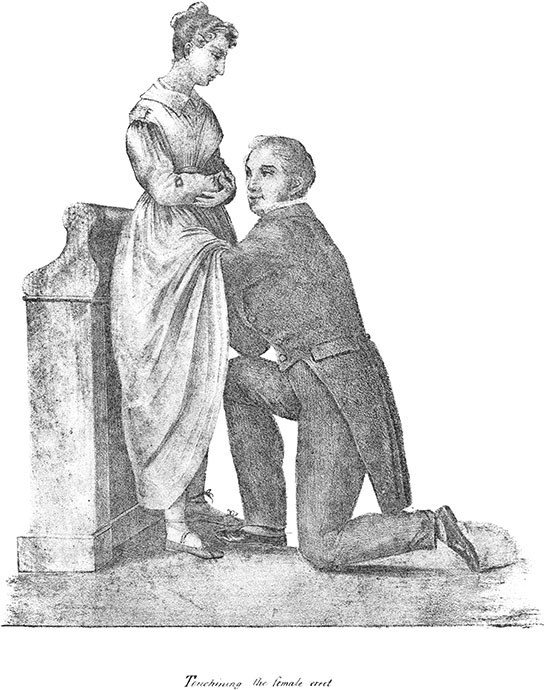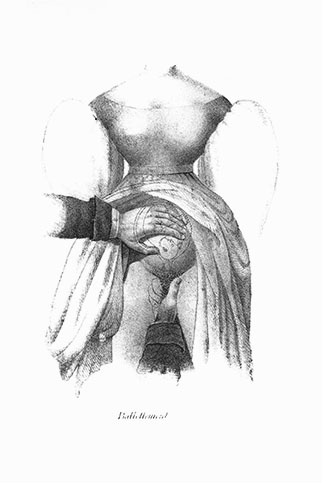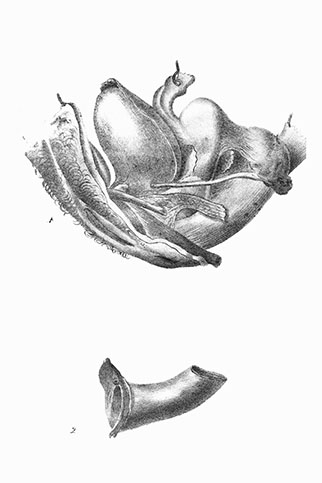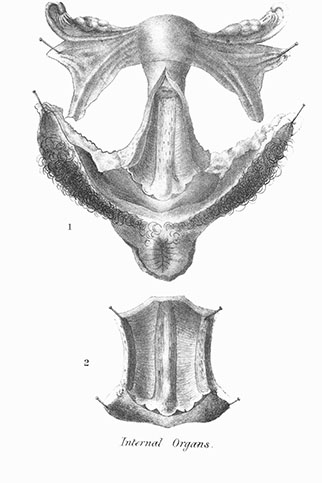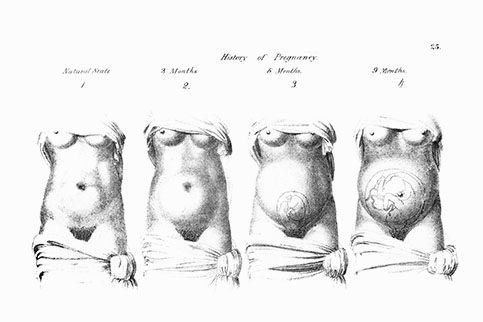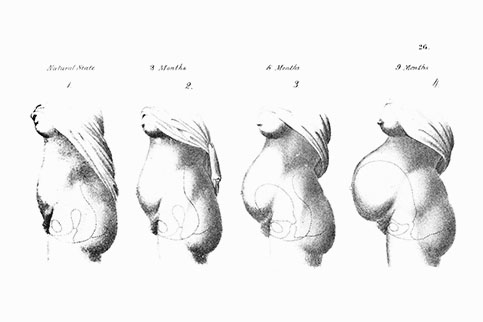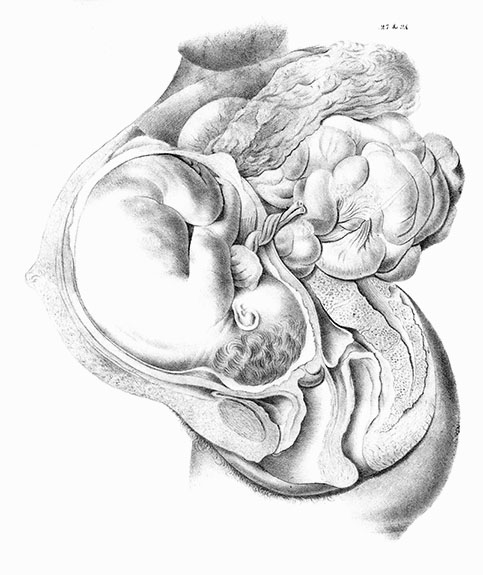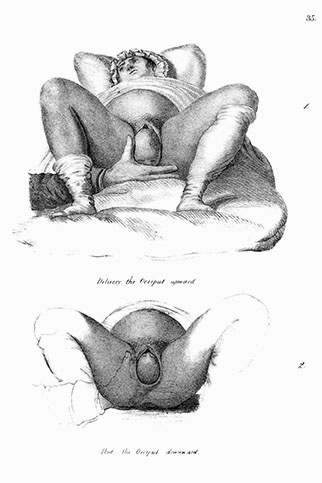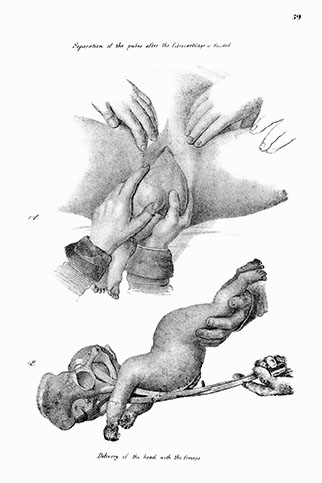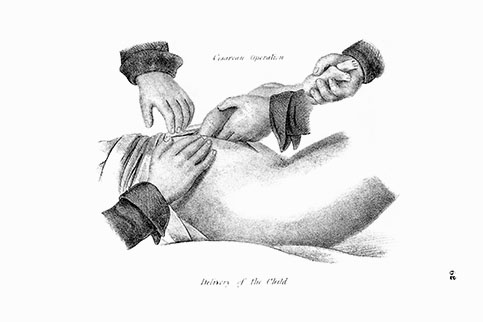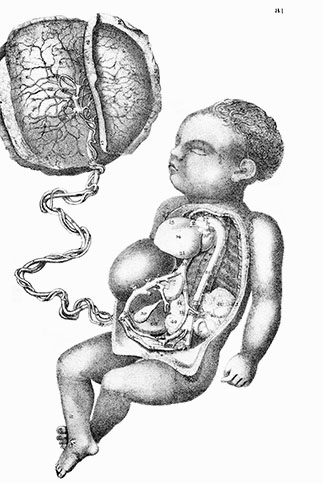52
Midwifery Illustrated
Jacques-Pierre Maygrier
This lithograph, from the sixth edition of Maygrier’s Midwifery Illustrated, shows the accoucheur determining the state of pregnancy by what we would now call digital examination, but what was known then by the suitably understated term “touching the female.” Maygrier’s work, published in the early days of obstetrics when male physicians were vying with female midwives over the institutional control of childbirth, illustrates the problematic situation early obstetricians were faced with. The idea was that the male physician could put his fingers wherever he wanted, but common decency in post-Empire France (or mid 19th-century America, for that matter) prevented him from actually looking.
Jacques-Pierre Maygrier (11 Jun 1771–1835) was born in Angouleme, France and at the age of 16 he entered the French navy, where he trained in surgery, eventually becoming the chief surgeon at the port city of Brest. In 1797, after a decade of naval practice, he went to Paris for further medical training. Here he studied anatomy under Antione Dubois, accoucheur of the Empress Marie Louise, interned at Hôpital Cochin and the Hôtel-Dieu, and eventually built up a sizable Parisian obstetrics practice, becoming “professeur libre d'accouchemens” for the Faculté de médecine.
Maygrier published several obstetric works while in Paris including Des qualitiés physiques et morales de l’accoucheur (Paris: Méquignon, 1801), Nouvelle méthode pour manoeuvrer les accouchements (Méquignon, 1804), Dissertation sur la délivrance (Méquignon, 1804) and Manuel de l’anatomiste (Paris: Éditions J.S. Merlin, 1811).
In 1822 he published the first part of his obstetric atlas, Nouvelles démonstrations d'accouchemens.1 Maygrier wanted to produce an altas from the point of view of the obstetrician rather than the general anatomist, such as Hunter, or the early male midwife, such as Smellie. As he wrote in the preface: “It will be, properly speaking, a pictured or graphic demonstration of obstetrics.” The atlas, which was published as as series folio installments, was a landmark text and has been described as “the best and most magnificent obstetrical atlas of the nineteenth century.”
Plates 27 and 28, AKA the centerfold
The illustrations were drawn by Antoine Chazal2 and the copperplate engravings were prepared by Forestier and François-Louis Couché le fils using the stipple and roulette (or “crayon”) technique. The results were beautiful early nineteenth-century French engravings.
Nouvelles démonstrations was reprinted in Brussels in 1825 and translated into Spanish (1828), Italian (1831),3 English (1833), Dutch (1836-38) and German (1836). The English translation by A. Sidney Foane under the title Midwifery Illustrated 4 became quite popular in the United States, eventually going through six editions.
All of the translated titles, which were published as much less expensive 8vo-sized books, reproduced Chazal’s illustrations as lithographs with rather predictable results: the lithographs don’t even begin to hint at the detail and artistry of the originals; cf. the following:

Nouvelles démonstrations, ca.1827

Nuove dimostrazioni di ostetricia, 1831

Midwifery Illustrated, 1850
1. In it’s full bibliographic glory: Maygrier, Jacques-Pierre. Nouvelles démonstrations d'accouchemens avec des planches en taille-douce, accompagnées d'un texte raisonné, propre à en faciliter l'explication, format in-folio. Paris: Béchet, Libraire, Place de l’École de Médicine. 1822–27. The large (40 × 25 cm) folio plates, 78 in all, including a double-sized plate, were published in 20 installments over five years. Not surprisingly, it is now quite difficult to find complete copies (and if you did you probably couldn’t afford it anyway). The text was reprinted in a deluxe facsimile by Editions Medicina Rara (New York, 1988). All of the plates are online at the BNF’s Gallica digital library.
2. Antoine Chazal (1793–1854) was best known for his botanical illustrations before his work for Maygrier. He later illustrated a number of anatomical works including Cruveilhier’s classic Anatomie pathologique du corps humain.
3. Maygrier, Jacques-Pierre, Fosgarini, M (trans.). Nuove dimostrazioni di ostetricia. Pisa: Tipografia Nistri e Comp, 1831. High-res images of the plates are available online at the Polo Biblioteche di Medicina dell'Università degli Studi di Padova’s Immed site.
4. Maygrier, Jacques-Pierre, Foane, A. S. (trans.). Midwifery Illustrated, sixth ed. New York: J. S. Bedfield, Clinton Hall, 1850. The book has been printed in facsimile several times. A copy of the second edition is available on Google Books. The scans above (and below) are but a fraction of the 82 plates in the sixth edition.

10 Jan 2010 ‧ Anatomicae
